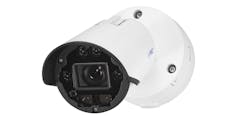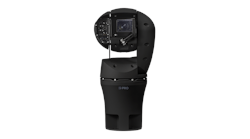All Good Video Must Come To an End!
I just completed managing two video projects and I must say I learned a few things, and relearned several more lessons, along the way. . The most important lessons I learned were, that as a Project Manager, one must:
- Accept the mess your customers and subcontractors dumped on you
- Make the best of the situation
- Use the correct tools
- Take care of your crew
- Watch your step when your walking above a sheetrock ceiling
- Don’t drag your ladder across a newly waxed floor while the custodians are watching
(Not necessarily in that order).
The two basic types of wire used for security and video are plenum and non-plenum. Plenum Wire and Plenum Cable are wire and cable products that can legally be installed in the plenum spaces of a building. The plenum space is the area that is used for air circulation of heating and air conditioning systems, usually located between the structural and suspended ceiling or under a raised floor.
Plenum products are coated with a flame-retardant material, so that in the event of a fire, it will not emit toxic fumes and smoke. In some areas, plenum wire is required by law.
No type of coaxial cable should be considered a substitute for a tow rope. This also applies to lighter gauge cables you may need to install, such as shielded two-conductor 22 gauge cable used for RS485 P/T/Z control. Low voltage cable is relatively delicate, and must be handled carefully. Pulling on it with excessive force will cause internal damage to the inner conductor and shield. Dragging it over sharp edges will slice the insulation which can cause grounding problems. Experienced wire installers know that they must essentially lay the wire over the ceiling, with special attention to where the cable takes turns.
Siamese type cable is frequently used for video systems. Siamese combines a coax cable with a two-conductor stranded power cable. Combining the two types of cable simplifies installation and reduces costs.
The most popular type for Siamese combines RG59 with two conductors of #18 gauge stranded. This combination works because the recommended maximum length of RG59 matches up with the voltage drop characteristics of two-conductor #18 for typical analog cameras.
Although texts will vary on recommended cable runs, 750 feet of 75 ohm coax is considered a reasonable limit. Voltage drop is dependent on input voltage and load, but you will observe workable voltage drops over 750 feet of two-conductor #18. We’re talking typical. You of course need to carefully survey your site, and evaluate your wire run lengths and power characteristics if you expect to turn over a successful project.
I like Altronix’ On-Line Voltage Drop Calculator (http://www.altronix.com/index.php?pid=4¬e=1). It automatically computes for a pair of wires.
Designers manage voltage drop in a number of ways. First you need to determine the tolerances of the cameras you are using. Plus or minus 10 percent is common. Some cameras allow the se of either 12VDC or 24VAC. This is helpful because current draw is lower at 24 VAC than at 12 VDC, so the voltage drop calculations are different.
In our Altronix example, given a camera load of 2 AMPs that is 400 feet from the power source, which wire gauge should be selected to keep voltage drop at the camera to less than 3 volts?
To use Chart 1, we need to determine the maximum voltage drop per 100 feet. We calculate that 100 feet is 1/4 of 400 feet, thus the voltage drop allowed for 100 feet is 1/4 times 3 volts (the equivalent of 0.75 volts per 100 feet):
Voltage drop per 100 feet = 3/4 = .75 volts per 100 feet.
So, knowing that we can not allow anything greater than a voltage drop of .75 volts per 100 feet, we use Chart 1 to select the wire gauges that will give us lower voltage drops per 100 feet at a 2 AMP load current. In this case, wire gauges of 10 (.40 V), 11 (.50 V), and 12 AWG (.64) will all suffice, with 13 AWG (.80) being a possibility.
Thus, to keep voltage drop at the camera to less than 3 volts given a camera load of 2 AMPs and a 400-foot paired wire run, we need to use a wire gauge in the range of 10-13 AWG.
Power supplies designed for video (like the Altronix R615DC616UL) frequently offer the ability to adjust the voltage output. So if you have excessive voltage drop in your cable, you can compensate by increasing the voltage output of your power supply.
Sometimes voltages to cameras can be tweaked using resisters or diodes in series with the wire to the camera. You need to know the wattage range of your camera before selecting a resister or a diode. By the way, maybe you didn’t know that a silicone diode will provide a .7 volt drop when placed in series with the voltage to your camera. (If you put it in there reverse biased it will stop all the voltage; you have to put it in forward biased.)
During our last installation, we used exterior PTZ cameras with heaters the required 24VAC and drew about 2 amps when the heaters were active. Unfortunately many of the cable runs were OK with the RG59 for the video signal, but the voltage drop was excessive due to the 2 amps that would be drawn when the heaters were on. The solution was to relocate the power supplies adjacent to the camera locations.
Another technology which can help with excessive cable runs is the use of UTP modules. For both of my projects, the bid spec prohibited the use of UTP. UTP is viable and works.
We got our wire from Windy City Wire. Their cable comes with footage and run markings on the insulation. When you just pulled a cable to a camera, you can look at the cable where it is exiting the box and know how long the run was. We were able to move several rolls of wire around as required, and also pull several cables at a time. By simply marking the cable’s end, you can identify which camera it is going to. This is way better than using electrical tape and a marker.
Installing cameras brings in another dimension to installation: height. Every camera is mounted high up. You are running wire off ladders and lifts. You are drilling through impenetrable walls off ladders and lifts. You are mounting and wiring cameras off ladders and lifts. We were having real problems drilling and pulling until we got the right tools.
One important tool was a SDS drill. This is very different from a conventional hammer drill like you would use to drill a safe, or make an occasional penetration to mount a card reader.
The SDS drill has an enhanced hammer action that when compared to a conventional hammer drill is able to deliver hundreds of times the energy per hammer blow. To go with this, it also has a different chuck design and special SDS drill bits to eliminate the possibility of bit slip, and also to withstand the force of its hammer action. When drilling hard masonry or engineering bricks, the difference is astonishing. Where an ordinary hammer drill may take minutes to make even a shallow hole, the SDS will pound through it in seconds.
But my recent school project was different. There were maybe 100 holes to drill. There were several guys drilling. There was a time limit for the project. Some of the installers were apprentices.
We were killing drills and destroying drill bits like crazy and burning up daylight and patience. It was actually a dangerous situation.
The SDS was like a silver bullet. The men were actually fighting over who got to drill the next hole. They were smiling as they drilled. The bits weren’t that more expensive than the other ones, and we only managed to break one, and it was the operator’s fault not the drill’s, or the bit’s, or the wall’s. Awesome.
Tim O'Leary
Tim O'Leary is a security consultant, trainer and technician who has also been writing articles on all areas of locksmithing & physical security for many years.





